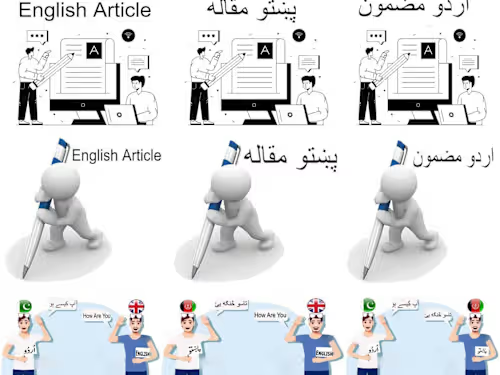
The Art of Teaching and Transcribing: English, Urdu, and Pashto.
Starting at
$
100
About this service
Summary
Process
FAQs
1. How can I improve my tutoring skills in English, Urdu, and Pashto?
Improving tutoring skills in English, Urdu, and Pashto requires a multi-faceted approach that encompasses language proficiency, cultural understanding, effective teaching methods, and continuous self-reflection. Here are some key strategies to enhance your tutoring skills in these languages: 1. Language Proficiency: - Continuously work on improving your own language skills in English, Urdu, and Pashto by reading extensively, practicing writing, and engaging in conversations with native speakers. - Stay updated on grammar rules, vocabulary, and idiomatic expressions in each language to ensure accurate and effective communication. 2. Cultural Understanding: - Develop a deep understanding of the cultural nuances and contexts associated with each language to provide meaningful and culturally sensitive tutoring sessions. - Incorporate cultural elements, such as literature, music, and traditions, into your lessons to make the learning experience more immersive and engaging for your students. 3. Effective Teaching Methods: - Tailor your tutoring approach to the unique needs and learning styles of each student in English, Urdu, and Pashto. - Utilize a variety of teaching strategies, such as visual aids, storytelling, role-playing, and interactive exercises, to cater to different learning preferences and enhance comprehension. 4. Feedback and Reflection: - Encourage open communication with your students to solicit feedback on your tutoring methods and materials in order to identify areas for improvement. - Regularly reflect on your teaching practices, assess student progress, and adjust your strategies accordingly to ensure continuous growth and effectiveness as a tutor. 5. Professional Development: - Engage in ongoing professional development opportunities, such as workshops, courses, and conferences related to language teaching and learning. - Stay current on best practices in language education, research trends, and advancements in language acquisition to incorporate innovative techniques into your tutoring sessions. By implementing these strategies and committing to continuous learning and improvement, you can enhance your tutoring skills in English, Urdu, and Pashto, and provide a more enriching educational experience for your students.
2. What are the best strategies for transcribing in English, Urdu, and Pashto?
Transcribing in English, Urdu, and Pashto requires attention to detail, language proficiency, and adherence to transcription standards. Here are the best strategies for transcribing in these languages: 1. Language Proficiency: Ensure a strong command of English, Urdu, and Pashto languages to accurately transcribe content. Familiarity with regional dialects, accents, and nuances is crucial for producing high-quality transcriptions. 2. Use of Transcription Software: Employ reliable transcription software that supports multiple languages to streamline the transcription process. Look for tools that offer features like time-coding, speaker identification, and editing capabilities. 3. Transcription Guidelines: Adhere to transcription guidelines specific to each language, such as punctuation rules, spelling conventions, and formatting requirements. Consistency in applying these guidelines results in clear and concise transcriptions. 4. Verbatim vs. Non-Verbatim Transcription: Determine the type of transcription required – verbatim (word-for-word) or non-verbatim (summarized). Consider the context of the transcription project to choose the appropriate style. 5. Proofreading and Editing: Review transcriptions carefully to rectify any errors in grammar, spelling, or accuracy. Editing plays a crucial role in ensuring the final transcript is error-free and aligns with the original context. 6. Maintain Confidentiality: Respect the privacy and confidentiality of the content being transcribed, especially when dealing with sensitive or confidential information. Adhere to data protection regulations and ethical standards. 7. Cultural Sensitivity: Be mindful of cultural nuances and context while transcribing in Urdu and Pashto. Consider the cultural implications of certain words, phrases, or expressions to ensure accurate and respectful transcriptions. 8. Continuous Learning: Stay updated with language trends, vocabulary changes, and linguistic advancements in English, Urdu, and Pashto. Continuous learning enhances transcription skills and ensures relevance in the evolving language landscape. By integrating these strategies into the transcription process, transcriptionists can deliver accurate, consistent, and professional transcriptions in English, Urdu, and Pashto. Adhering to best practices and emphasizing language proficiency are key to producing high-quality transcriptions that meet the needs of diverse language audiences.
3. Which online platforms offer courses in English, Urdu, and Pashto tutoring?
Several online platforms offer courses in English, Urdu, and Pashto tutoring. Some popular platforms include: 1. iTalki: iTalki connects language learners with native speakers for online language tutoring in English, Urdu, and Pashto. 2. Verbling: Verbling offers online language tutoring in English, Urdu, and Pashto with professional tutors. 3. Preply: Preply is a platform where you can find tutors for English, Urdu, and Pashto. Tutors offer personalized lessons through video calls. 4. Cambly: Cambly provides on-demand English tutoring with native speakers through its online platform. 5. WizIQ: WizIQ offers online language courses in English, Urdu, and Pashto with interactive lessons and live classes. These platforms offer a range of options for language learners to improve their English, Urdu, and Pashto skills through personalized tutoring sessions, interactive lessons, and access to native-speaking tutors.
4. What are the benefits of learning English, Urdu, and Pashto simultaneously?
Learning English, Urdu, and Pashto simultaneously offers a myriad of benefits, both linguistically and culturally. These three languages belong to distinct language families – English being a Germanic language, Urdu a member of the Indo-Aryan family, and Pashto an Iranian language. By learning all three, individuals can develop a deep understanding of diverse language structures, enhancing cognitive flexibility and creative thinking. From a practical standpoint, proficiency in English, Urdu, and Pashto opens up a world of opportunities in terms of global communication and career advancement. English is widely regarded as the global lingua franca, essential for international business, academia, and diplomacy. Urdu, one of the official languages of Pakistan, is crucial for engaging with its rich literary heritage and local communities. Similarly, Pashto plays a vital role in fostering connections with the Pashtun people, primarily residing in Afghanistan and Pakistan. Moreover, mastering these three languages can lead to enhanced cultural appreciation and cross-cultural communication skills. Each language carries unique cultural nuances, idioms, and expressions that offer insights into the histories, traditions, and values of the communities where they are spoken. By learning English, Urdu, and Pashto together, individuals can navigate complex social contexts with sensitivity and understanding, fostering meaningful relationships and cooperation across linguistic barriers. Furthermore, the cognitive benefits of multilingualism are well-documented, including improved memory, multitasking abilities, and cognitive reserve. Learning three languages simultaneously can amplify these advantages, stimulating the brain in diverse ways and promoting cognitive growth. This linguistic dexterity not only enhances problem-solving skills but also boosts overall mental agility, contributing to lifelong learning and intellectual enrichment. In conclusion, the benefits of learning English, Urdu, and Pashto simultaneously extend beyond linguistic proficiency to encompass cultural appreciation, career opportunities, cognitive enhancement, and interpersonal skills. By embarking on this multilingual journey, individuals can broaden their horizons, enrich their understanding of the world, and forge meaningful connections across diverse linguistic and cultural landscapes.
5. How can I effectively manage time while tutoring and transcribing in English, Urdu, and Pashto?
Effectively managing time while tutoring and transcribing in multiple languages such as English, Urdu, and Pashto requires a structured approach and effective time management strategies. Here are some key concepts and insights to help you navigate this juggling act successfully: 1. Prioritize Tasks: Identify the most important and urgent tasks in each language you need to tackle. Set clear priorities based on deadlines, complexity, or criticality. 2. Establish a Schedule: Create a daily or weekly schedule that allocates specific time blocks for tutoring and transcribing in each language. Stick to this schedule as much as possible to maintain consistency and avoid overlap. 3. Utilize Time Blocks: Divide your work into manageable time blocks for each language, allowing for focused and efficient work without feeling overwhelmed. 4. Use Time Management Tools: Make use of time management tools such as calendars, task lists, or apps to help you track deadlines, set reminders, and stay organized across various language tasks. 5. Avoid Multitasking: While it may seem efficient to work on multiple languages simultaneously, it can lead to decreased focus and productivity. Concentrate on one language at a time to ensure quality and accuracy. 6. Take Breaks: Incorporate short breaks between language tasks to recharge your mind and prevent burnout. This can help maintain your energy levels and productivity throughout the day. 7. Delegate or Outsource: Consider delegating tasks or outsourcing certain aspects of your tutoring or transcribing work in specific languages to trusted colleagues or professionals. This can help lighten your workload and free up time for other priorities. By implementing these strategies, you can effectively manage time while balancing tutoring and transcribing in multiple languages, ensuring productivity, quality, and satisfaction in your work.
6. What Are the Requirements to Become an English, Urdu, and Pashto Tutor and Transcriber?
To become an English, Urdu, and Pashto tutor and transcriber, several requirements need to be met. For tutoring, individuals typically need a bachelor's degree in English, Urdu, or Pashto, or a related field. Strong communication skills, teaching experience, and proficiency in the language(s) are essential. Obtaining a teaching certificate or completing a tutoring training program can also be beneficial. For transcribing, a high level of proficiency in typing and knowledge of transcription software are necessary. Familiarity with the specific language's grammar, vocabulary, and nuances is crucial for accurate transcription work. Attention to detail, ability to meet deadlines, and maintaining confidentiality are also important skills in transcribing. In addition to educational and skill requirements, having a passion for languages, cultural sensitivity, and adaptability to different learning styles or transcription requirements is key. Continuous learning and staying updated on language trends or transcription techniques are necessary to excel in these roles. Building a strong portfolio showcasing your expertise and experience in tutoring or transcribing can help in securing opportunities in these fields. Networking with language professionals and joining relevant associations can also enhance one's career prospects as an English, Urdu, and Pashto tutor and transcriber.
7. How Can I Improve My Skills as an English, Urdu, and Pashto Tutor and Transcriber?
Improving your skills as an English, Urdu, and Pashto tutor and transcriber requires a combination of dedication, practice, and continuous learning. Here are some key strategies to help you enhance your proficiency in these areas: 1. Master the Languages: Develop a strong command of English, Urdu, and Pashto by immersing yourself in these languages through reading, writing, listening, and speaking on a regular basis. Practice with native speakers to improve your fluency and accuracy. 2. Stay Updated: Stay current with the latest developments in the languages you teach and transcribe. Follow reputable sources, read literature, watch films, and listen to music in English, Urdu, and Pashto to expand your vocabulary and understanding of language nuances. 3. Seek Feedback: Request feedback from your students or clients to identify areas for improvement. Use constructive criticism to refine your teaching and transcription methods and address any weaknesses. 4. Attend Workshops and Training: Participate in workshops, seminars, and training programs focused on language teaching, transcription techniques, and language proficiency. These opportunities can help you acquire new skills and stay abreast of best practices in the field. 5. Utilize Technology: Make use of language learning apps, online resources, transcription tools, and software to streamline your work processes and enhance your efficiency as a tutor and transcriber. 6. Practice Regularly: Dedicate time each day to practice teaching, transcribing, and honing your language skills. Consistent practice is key to mastering languages and improving your instructional and transcription abilities. 7. Collaborate with Peers: Engage with other language tutors and transcribers to exchange ideas, share resources, and learn from each other's experiences. Collaborating with peers can provide valuable insights and support for your professional development. By incorporating these strategies into your routine, you can enhance your skills as an English, Urdu, and Pashto tutor and transcriber, ultimately providing better support for your students or clients and furthering your own proficiency in these languages.
8. What Are the Challenges Faced by English, Urdu, and Pashto Tutors and Transcribers?
English, Urdu, and Pashto tutors and transcribers face unique challenges in their work, stemming from the intricate nature of each language. For English tutors and transcribers, common challenges include dealing with regional dialects, nuances in grammar and vocabulary, as well as the ever-evolving nature of the language. In contrast, Urdu tutors and transcribers often struggle with the complexity of Urdu script, which has both Nastaliq and Naskh styles, leading to transcription errors and misinterpretations. Additionally, the varying levels of formality in Urdu language usage present challenges in maintaining consistency in educational materials or transcriptions. On the other hand, Pashto tutors and transcribers encounter difficulties related to the oral nature of the language, as Pashto has a strong tradition of oral storytelling and poetry, making it challenging to accurately transcribe spoken texts. Moreover, the vast array of dialects and variations in Pashto across different regions adds another layer of complexity for tutors and transcribers to navigate. Overall, English, Urdu, and Pashto tutors and transcribers face distinct challenges related to language intricacies, dialect variations, script complexities, and cultural nuances, highlighting the need for specialized skills and knowledge in working with these languages. Finding effective strategies to overcome these challenges is crucial for ensuring accurate and high-quality educational materials and transcriptions in English, Urdu, and Pashto.
9. Where Can I Find Job Opportunities as an English, Urdu, and Pashto Tutor and Transcriber?
As an English, Urdu, and Pashto tutor and transcriber, there are several avenues where you can find job opportunities. Here are some key places to explore: 1. Online Tutoring Platforms: Websites such as iTalki, Preply, and Verbling offer opportunities for language tutors to connect with students from around the world. You can create a profile highlighting your expertise in English, Urdu, and Pashto and start offering your services to students seeking language instruction. 2. Freelance Job Platforms: Platforms like Upwork, Freelancer, and Fiverr allow you to create profiles and bid on projects related to tutoring and transcription services. Employers frequently post job opportunities for language tutors and transcriptionists, providing a steady stream of potential work. 3. Language Schools and Institutes: Local language schools, community colleges, and institutes often hire language instructors for both in-person and online teaching positions. Reach out to these establishments with your resume and a cover letter highlighting your qualifications and experience in English, Urdu, and Pashto tutoring. 4. Transcription Companies: Companies specializing in transcription services may have a need for individuals fluent in multiple languages for transcribing audio and video content. Contact these companies directly or check their websites for job postings related to Urdu and Pashto transcription work. 5. Social Media and Networking: Utilize social media platforms like LinkedIn, Facebook groups, and Twitter to network with potential clients and showcase your language tutoring and transcription skills. Join relevant groups and communities where individuals interested in language learning and transcription services gather. By exploring these avenues and actively seeking out opportunities, you can increase your chances of finding job opportunities as an English, Urdu, and Pashto tutor and transcriber. Remember to tailor your applications and pitches to highlight your proficiency in these languages and emphasize your experience in tutoring and transcription. Good luck with your job search!
10. What Are the Benefits of Being an English, Urdu, and Pashto Tutor and Transcriber?
Being an English, Urdu, and Pashto tutor and transcriber comes with a myriad of benefits. Firstly, it allows you to contribute to linguistic diversity by helping individuals learn and improve their language skills in three different languages. This not only enhances their communication abilities but also promotes cross-cultural understanding and global connections. Secondly, being a tutor and transcriber in these languages opens up a wide range of opportunities for professional growth and development. You can work in various sectors such as education, translation, interpretation, and content creation, enhancing your expertise in multiple linguistic domains. Furthermore, tutoring and transcribing in these languages can be personally fulfilling as you witness your students or clients progress and succeed in their language learning journey. The sense of satisfaction derived from helping others achieve their language goals is invaluable and can nurture a sense of accomplishment in your own work. Moreover, being proficient in English, Urdu, and Pashto gives you a competitive edge in the job market, as multilingual skills are highly sought after in various industries. This can lead to increased job prospects, higher earning potential, and more opportunities for career advancement. In conclusion, being an English, Urdu, and Pashto tutor and transcriber is not only academically and professionally rewarding but also allows you to make a positive impact on individuals and society as a whole. Embracing these opportunities can lead to a fulfilling and successful career path in the field of language education and communication.
What's included
The Ultimate Guide to English, Urdu, and Pashto Teaching and Transcription
Our comprehensive language teaching and transcription service offers a unique blend of English, Urdu, and Pashto instruction, catering to individuals looking to enhance their language skills or businesses in need of accurate transcription services. Our team of experienced instructors and transcribers are native speakers of each language, ensuring top-quality education and transcription accuracy. Whether you are a beginner looking to learn a new language or a company in need of precise transcription services, our tailored approach guarantees satisfaction and success. With a focus on practical application and real-world scenarios, our services are designed to meet the diverse needs of our clients, making language learning and transcription a seamless and rewarding experience.
Duration
1 week
Skills and tools
Tutor
Transcriber
Translator

Gmail

Google Docs

Microsoft Word

Python
Industries
